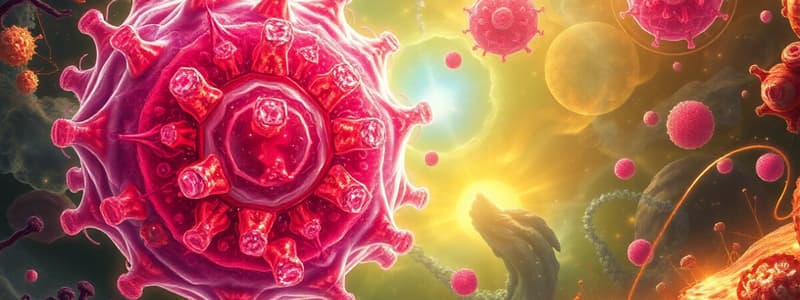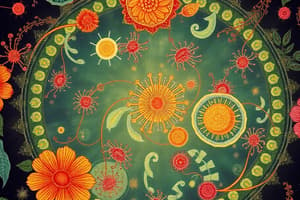Podcast
Questions and Answers
What is the scientific study of life called?
What is the scientific study of life called?
- Chemistry
- Geology
- Biology (correct)
- Physics
According to cell theory, what are the basic units of structure and function in living organisms?
According to cell theory, what are the basic units of structure and function in living organisms?
- Tissues
- Organisms
- Cells (correct)
- Organs
What is the process that drives evolution, favoring individuals with advantageous traits?
What is the process that drives evolution, favoring individuals with advantageous traits?
- Gene flow
- Natural selection (correct)
- Genetic drift
- Random mutation
What is the term for the maintenance of a stable internal environment in living organisms?
What is the term for the maintenance of a stable internal environment in living organisms?
Which level of biological organization includes all parts of Earth inhabited by living organisms?
Which level of biological organization includes all parts of Earth inhabited by living organisms?
What is the science of classifying and naming organisms?
What is the science of classifying and naming organisms?
Which domain of life includes organisms with cells containing a nucleus?
Which domain of life includes organisms with cells containing a nucleus?
Which biomolecule provides energy and structural support and includes sugars and starches?
Which biomolecule provides energy and structural support and includes sugars and starches?
What type of cell lacks a nucleus and other membrane-bound organelles?
What type of cell lacks a nucleus and other membrane-bound organelles?
Which organelle generates energy through cellular respiration?
Which organelle generates energy through cellular respiration?
What is the sum of all chemical reactions in an organism called?
What is the sum of all chemical reactions in an organism called?
What molecule is the primary energy currency of the cell?
What molecule is the primary energy currency of the cell?
In what organelle does photosynthesis occur in plant cells?
In what organelle does photosynthesis occur in plant cells?
What molecule carries genetic information?
What molecule carries genetic information?
What is the process by which RNA is synthesized from a DNA template?
What is the process by which RNA is synthesized from a DNA template?
What type of cell division produces two identical daughter cells?
What type of cell division produces two identical daughter cells?
Who formulated the laws of inheritance?
Who formulated the laws of inheritance?
What is the movement of genes between populations called?
What is the movement of genes between populations called?
What are the non-living components of the environment called?
What are the non-living components of the environment called?
What is the variety of life on Earth known as?
What is the variety of life on Earth known as?
Flashcards
What is Biology?
What is Biology?
The scientific study of life, encompassing its structure, function, growth, origin, evolution, and distribution of living organisms.
Cell Theory
Cell Theory
All living organisms are composed of cells; cells are the basic units of structure and function; and all cells arise from pre-existing cells.
Gene Theory
Gene Theory
Traits are inherited through specific regions of DNA that code for particular characteristics.
Evolution
Evolution
Signup and view all the flashcards
Homeostasis
Homeostasis
Signup and view all the flashcards
Biosphere
Biosphere
Signup and view all the flashcards
Ecosystem
Ecosystem
Signup and view all the flashcards
Community (Ecology)
Community (Ecology)
Signup and view all the flashcards
Population (Ecology)
Population (Ecology)
Signup and view all the flashcards
Taxonomy
Taxonomy
Signup and view all the flashcards
Bacteria
Bacteria
Signup and view all the flashcards
Archaea
Archaea
Signup and view all the flashcards
Eukarya
Eukarya
Signup and view all the flashcards
Carbohydrates
Carbohydrates
Signup and view all the flashcards
Lipids
Lipids
Signup and view all the flashcards
Proteins
Proteins
Signup and view all the flashcards
Nucleic Acids
Nucleic Acids
Signup and view all the flashcards
Prokaryotic Cells
Prokaryotic Cells
Signup and view all the flashcards
Eukaryotic Cells
Eukaryotic Cells
Signup and view all the flashcards
Metabolism
Metabolism
Signup and view all the flashcards
Study Notes
- Biology is the scientific study of life
- It encompasses the structure, function, growth, origin, evolution, and distribution of living organisms
Core Principles of Biology
- Cell theory: All living organisms are composed of cells
- Cells are the basic units of structure and function in living organisms
- All cells arise from pre-existing cells
- Gene theory: Traits are inherited through genes
- Genes are specific regions of DNA that code for particular traits
- Evolution: Life on Earth has evolved over time through a process of descent with modification
- Natural selection drives this process, favoring individuals with advantageous traits
- Homeostasis: Living organisms maintain a stable internal environment
- This is achieved through various regulatory mechanisms
Levels of Biological Organization
- Biosphere: The part of Earth inhabited by living organisms
- Ecosystem: A community of interacting organisms and their physical environment
- Community: Populations of different species living in the same area
- Population: A group of individuals of the same species living in the same area
- Organism: An individual living being
- Organ System: A group of organs working together to perform a specific function
- Organ: A structure composed of different tissues working together to perform a specific function
- Tissue: A group of similar cells performing a specific function
- Cell: The basic unit of life
- Organelle: A structure within a cell that performs a specific function
- Molecule: A group of atoms bonded together
Classification of Living Organisms
- Taxonomy is the science of classifying and naming organisms
- The current classification system includes:
- Domain
- Kingdom
- Phylum
- Class
- Order
- Family
- Genus
- Species
Three Domains of Life
- Bacteria: Prokaryotic, single-celled organisms
- Archaea: Prokaryotic, single-celled organisms that often live in extreme environments
- Eukarya: Eukaryotic organisms with cells containing a nucleus and other membrane-bound organelles
- Includes protists, fungi, plants, and animals
Key Biomolecules
- Carbohydrates: Provide energy and structural support
- Examples include sugars, starches, and cellulose
- Lipids: Store energy, form cell membranes, and act as hormones
- Examples include fats, oils, and steroids
- Proteins: Perform a wide variety of functions, including catalysis, transport, and structural support
- Composed of amino acids
- Nucleic acids: Store and transmit genetic information
- DNA and RNA are examples
Cell Structure and Function
- Prokaryotic cells: Lack a nucleus and other membrane-bound organelles
- Bacteria and archaea
- Eukaryotic cells: Contain a nucleus and other membrane-bound organelles
- Protists, fungi, plants, and animals
- Key organelles in eukaryotic cells:
- Nucleus: Contains the cell's DNA
- Mitochondria: Generate energy through cellular respiration
- Ribosomes: Synthesize proteins
- Endoplasmic reticulum (ER): Involved in protein and lipid synthesis
- Golgi apparatus: Modifies and sorts proteins
- Lysosomes: Break down waste materials
- Chloroplasts (in plant cells): Carry out photosynthesis
Energy and Metabolism
- Metabolism: The sum of all chemical reactions in an organism
- Catabolism: Breakdown of complex molecules into simpler ones, releasing energy
- Anabolism: Synthesis of complex molecules from simpler ones, requiring energy
- Enzymes: Catalyze biochemical reactions by lowering activation energy
- ATP (adenosine triphosphate): The primary energy currency of the cell
Photosynthesis
- The process by which plants and other organisms convert light energy into chemical energy
- Occurs in chloroplasts
- Involves two main stages:
- Light-dependent reactions: Convert light energy into chemical energy (ATP and NADPH)
- Light-independent reactions (Calvin cycle): Use ATP and NADPH to fix carbon dioxide and produce glucose
Cellular Respiration
- The process by which cells break down glucose to generate ATP
- Occurs in mitochondria
- Involves three main stages:
- Glycolysis: Breaks down glucose into pyruvate
- Krebs cycle (citric acid cycle): Oxidizes pyruvate to produce ATP, NADH, and FADH2
- Electron transport chain: Uses NADH and FADH2 to generate a proton gradient, which drives ATP synthesis
Genetics
- Genes: Units of heredity that determine traits
- DNA (deoxyribonucleic acid): The molecule that carries genetic information
- Double-stranded helix composed of nucleotides
- Nucleotides consist of a sugar, a phosphate group, and a nitrogenous base (adenine, guanine, cytosine, or thymine)
- RNA (ribonucleic acid): Involved in protein synthesis
- Single-stranded
- Contains uracil instead of thymine
- Chromosomes: Structures that carry genes; composed of DNA and proteins
- Gene expression: The process by which genetic information is used to synthesize proteins
DNA Replication
- The process by which DNA is copied
- Ensures that each daughter cell receives a complete set of chromosomes
- Involves several enzymes, including DNA polymerase
Transcription
- The process by which RNA is synthesized from a DNA template
- Occurs in the nucleus
- Involves RNA polymerase
Translation
- The process by which proteins are synthesized from RNA
- Occurs on ribosomes
- Involves tRNA (transfer RNA), which carries amino acids to the ribosome
Cell Division
- Mitosis: Cell division that produces two identical daughter cells
- Used for growth, repair, and asexual reproduction
- Meiosis: Cell division that produces four genetically different daughter cells (gametes)
- Used for sexual reproduction
- Cell cycle: The series of events that take place in a cell leading to its division and duplication
Mendelian Genetics
- Gregor Mendel's laws of inheritance:
- Law of segregation: Each individual has two alleles for each trait, and these alleles separate during gamete formation
- Law of independent assortment: Alleles for different traits are inherited independently of each other
Evolution
- Evolution: Change in the genetic makeup of a population over time
- Natural selection: The process by which individuals with advantageous traits are more likely to survive and reproduce
- Mechanisms of evolution:
- Mutation: Changes in DNA sequence
- Gene flow: Movement of genes between populations
- Genetic drift: Random changes in allele frequencies
- Natural selection
Evidence for Evolution
- Fossil record: Shows the history of life on Earth
- Comparative anatomy: Similarities in the anatomy of different species indicate common ancestry
- Embryology: Similarities in the development of different species indicate common ancestry
- Molecular biology: Similarities in DNA and protein sequences indicate common ancestry
- Biogeography: The distribution of species on Earth reflects their evolutionary history
Ecology
- Ecology: The study of the interactions between organisms and their environment
- Population ecology: Studies the dynamics of populations, including birth rates, death rates, and migration
- Community ecology: Studies the interactions between different species in a community
- Ecosystem ecology: Studies the flow of energy and nutrients through ecosystems
Ecosystem Components
- Abiotic factors: Non-living components of the environment, such as temperature, water, and sunlight
- Biotic factors: Living components of the environment, such as plants, animals, and microorganisms
- Trophic levels: The position an organism occupies in a food chain
- Producers: Autotrophs that produce their own food through photosynthesis or chemosynthesis
- Consumers: Heterotrophs that obtain energy by consuming other organisms
- Decomposers: Break down dead organic matter
Biodiversity
- The variety of life on Earth
- Includes genetic diversity, species diversity, and ecosystem diversity
- Importance of biodiversity:
- Provides essential ecosystem services
- Supports human health and well-being
- Has intrinsic value
- Threats to biodiversity:
- Habitat loss
- Invasive species
- Pollution
- Climate change
- Overexploitation
Viruses
- Acellular infectious agents
- Consist of a nucleic acid genome (DNA or RNA) surrounded by a protein coat (capsid)
- Obligate intracellular parasites- require a host cell to replicate
- Viral replication involves attachment, penetration, replication, assembly, and release
Bacteria
- Prokaryotic, single-celled organisms
- Possess a cell wall, ribosomes, and a circular chromosome
- Reproduce through binary fission
- Play important roles in nutrient cycling, decomposition, and disease
Studying That Suits You
Use AI to generate personalized quizzes and flashcards to suit your learning preferences.




